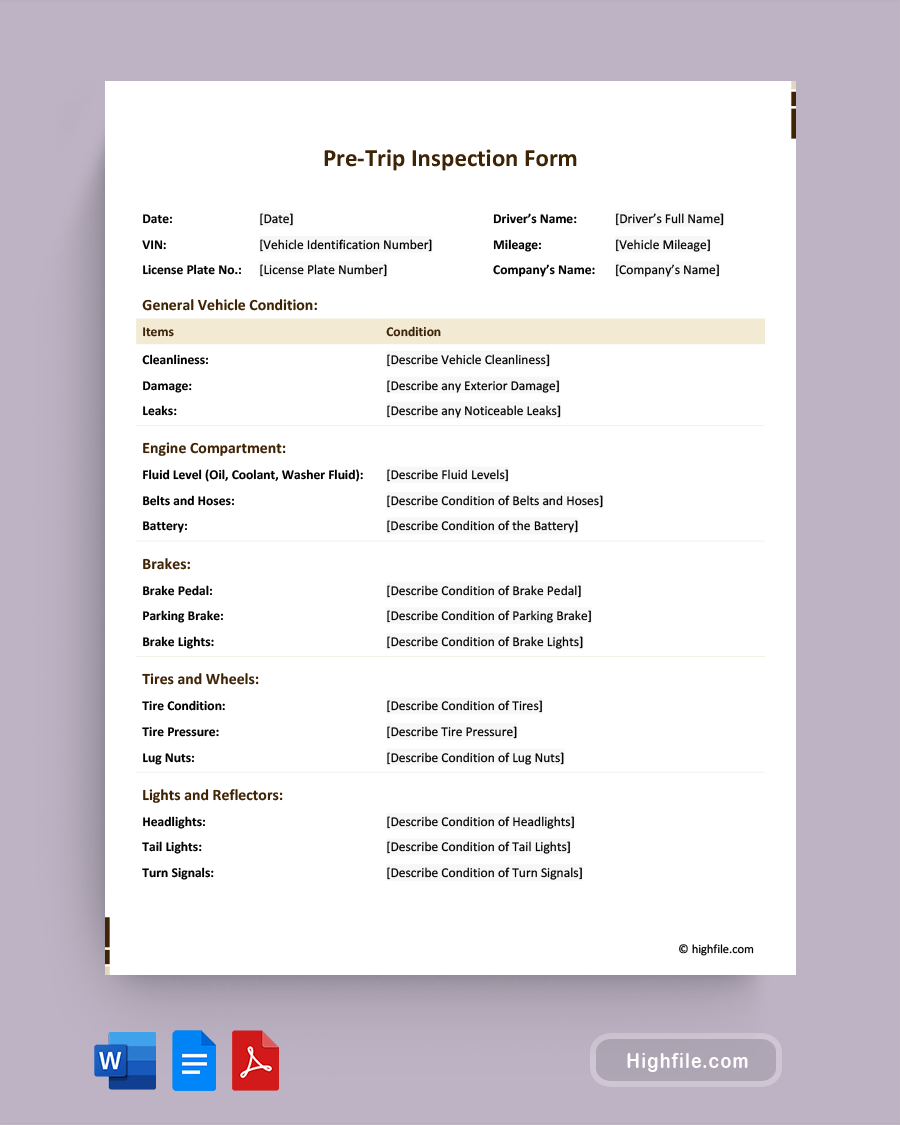If you’ve ever had a blowout, breakdown, or other vehicle malfunction on the road, then you know what a hassle it can be. Sadly, there’s no way to guarantee it will never happen again except to stop driving, which just isn’t practical. However, there is an easy solution that can help minimize any chances of problems on your road trips. A Pre Trip Inspection Form can help ensure you’ve done all you can to check your vehicle before taking a long ride anywhere. Professional drivers will find this document especially helpful. Best of all, our Pre Trip Inspection Form is easy to download, modify and use. Read on, and we’ll share everything you need to know so you can travel stress-free.
What Is a Pre Trip Inspection Form?
Professionals use a Pre Trip Inspection Form in transportation and logistics industries to assess the condition of a vehicle before embarking on a trip. However, you can also use one at home. A good inspection is crucial for ensuring the vehicle’s safety. It helps identify any potential issues and addresses them promptly to prevent accidents and breakdowns during the journey. This useful form typically includes a categorized list of items to inspect and check off. It covers the vehicle’s essential components and allows drivers to record their observations and comments. Having this form can help prevent mistakes and ensure every part of a vehicle has been looked over carefully.
Why Is Pre Trip Inspection Form Important?
A pre trip inspection form is important for numerous reasons, not the least of which is that it is often required. In industries that use vehicles regularly, many areas require inspections by law, but even if they didn’t it’s still a practical thing to do. Here are all the reasons why you should always use this checklist before a long trip:
- Ensures Vehicle Safety: The inspection form helps drivers identify potential mechanical issues, malfunctions, or damages. Anything that could compromise the vehicle’s safety while on the road needs to be addressed immediately.
- Prevents Breakdowns: By addressing minor problems before departure, the form minimizes the risk of breakdowns. This also reduces the chances of costly repairs during the trip.
- Compliance with Regulations: Many jurisdictions mandate pre-trip inspections for commercial vehicles. Adhering to these regulations helps companies avoid penalties and legal issues, and having a professionally designed Pre Trip Inspection Form helps show their willingness to comply.
- Protects Cargo Integrity: A thorough inspection ensures that cargo is secured properly. It reduces the likelihood of load shifts, lost cargo, or damages during transit.
- Reduces Liability: Properly documented inspections demonstrate due diligence and responsible vehicle maintenance. This helps reduce liability in the event of an accident.
- Cultivates Safety Awareness: Encouraging drivers to conduct regular inspections fosters a safety-conscious culture. Promoting responsible driving habits is just smart.
Essential Elements of Pre Trip Inspection Form
The essential elements of a pre-trip inspection form are fairly predictable. They include categories for different parts of the vehicle and what to check. Here is what you should expect to see in this document:
- Title: Clearly label the form as “Pre Trip Inspection Form” for easy identification.
- Date: Record the inspection date to track maintenance schedules and compliance.
- Driver’s Name: Input the driver’s full name for accountability and reference.
- Vehicle Identification Number (VIN): Note the unique VIN to identify the vehicle accurately.
- Vehicle Mileage: List the current mileage to monitor usage and plan maintenance.
- License Plate Number: Document the license plate number for identification purposes.
- Company Name: Add the company or organization’s name for fleet management.
- General Vehicle Condition: Evaluate the vehicle’s cleanliness, exterior damage, and any signs of leaks.
- Engine Compartment: Check fluid levels, belts, battery condition, and overall engine health.
- Brakes: Look at the brake pedal, parking brake, and brake lights for proper functioning.
- Tires and Wheels: Inspect tire condition, pressure, and the tightness of lug nuts.
- Lights and Reflectors: Check headlights, taillights, turn signals, and reflectors for visibility.
- Steering and Horn: Verify the steering system’s responsiveness and functionality of the horn.
- Windshield and Mirrors: Ensure clear visibility through the windshield and properly adjusted mirrors.
- Safety Equipment: Confirm the presence and accessibility of seatbelts, fire extinguishers, and a first aid kit.
- Cargo Securement (If Applicable): Assess cargo loading and securement procedures for compliance.
- Comments: This section is for drivers to provide additional notes or remarks about the inspection.
- Driver Signature: The driver signs the form to acknowledge the inspection’s completion.
- Time: Record the time of the inspection.
Pro Tip: The best and simplest way to handle your pre trip vehicle safety inspection is with a professional Pre Trip Inspection Form Template or a dedicated mobile application. Using these pre-made options helps save time, enhance accuracy, and it can have other advantages as well. For example, apps can include automated reminders.
FAQs
The vehicle operator or driver is generally responsible for conducting Pre Trip Inspections. Whether it’s a professional truck driver, a company fleet operator, or an individual using a personal vehicle for business purposes, all drivers must perform these inspections before heading out. In commercial transportation, fleet management may also require drivers to report their inspection findings to ensure compliance with safety standards. However, as employers, businesses are also partially responsible for ensuring drivers perform their inspections.
Using a Pre Trip Inspection Form has many advantages. It contributes to overall road safety, regulatory compliance, and effective fleet management. Here are the key benefits of this form:
– It enhances road safety.
– The Pre Trip Inspection Form ensures compliance with these regulations, avoiding penalties.
– It helps ensure proper cargo securement and safeguards goods from damage or shifting during transit.
– It minimizes the need for costly repairs and downtime.
– Documented inspections demonstrate responsible vehicle maintenance and protect against liability in accidents.
– It reminds drivers to conduct inspections fostering a safety-conscious mindset.
– It reduces the risk of accidents caused by mechanical failures.
– A timely inspection can catch a major problem and even save lives.
The results of a Pre Trip Inspection should be documented or recorded using the designated Pre Trip Inspection Form. Drivers must complete the form, noting the date, their name, vehicle information, and the findings. All observed issues should be included. The driver’s signature adds a crucial layer of accountability. The documented information should be securely, either stored physically or digitally, depending on the organization’s preferences, so it is accessible for review, compliance audits, and future reference.
A Pre Trip Inspection Form can be used for regulatory compliance purposes. They are especially important in the commercial transportation and logistics industries. Many jurisdictions have specific regulations that mandate pre trip inspections for commercial vehicles to ensure the safety of drivers, passengers, and other road users. By consistently conducting and properly documenting these inspections, companies, and drivers can demonstrate compliance and avoid potential fines, penalties, and legal complications.
Key Points
The Pre Trip Inspection Form is crucial and often legally mandated to ensure vehicle safety. These documents promote responsible driving habits and compliance with regulatory requirements. By meticulously inspecting various vehicle components before each journey, drivers can identify potential issues and address them proactively. Doing this minimizes the risk of accidents, injuries, breakdowns, delays, and costly repairs. Thoroughly documenting the inspection results not only provides a basis for regular maintenance but also offers legal protection. Investing time and effort into these inspections is an investment in the safety and well-being of the drivers, vehicles, and everyone on the road.







